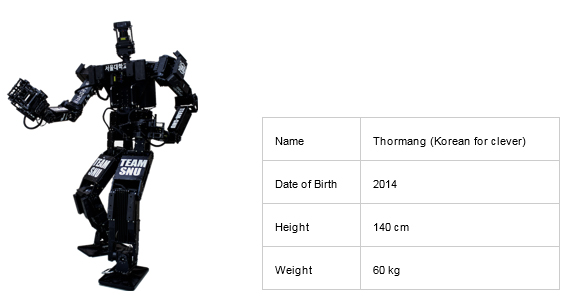In June, Team Seoul National University (SNU) participated in the finals of the DARPA Robotics Competition (DRC), held in Pomona, California. It was organized by the Defense Advanced Research Projects Agency (DARPA), an agency of the U.S. Department of Defense, responsible for the development of emerging technologies for use in the military.
Team SNU was established in September 2014 and began working with its humanoid robot, Thormang, designed by the Korean robotics company, Robotis in January 2015. The group comprised of nineteen people led by Professor PARK Jae-heung (Graduate School of Convergence Science and Technology), director of the Digital Human Research Center. The team consisted of Associate Professor KWAK No-jun (Graduate School of Convergence Science and Technology), graduate students from the Graduate School of Convergence Science and Technology and employees from SimLab, an external Korean technology company that develops robotics simulations.

Thormang, SNU team’s robot
Team SNU was divided into three subgroups in order to maximize efficiency: Professor PARK Jae-heung’s group, Professor KWAK No-jun’s group, and the group from SimLab. Professor PARK Jae-heung’s group was in charge of preparing for the competition, and perfecting the robotic controls and movements to overcome the obstacles that were present in the competition, whereas Professor KWAK No-jun’s group was in charge of the robotic visual sensors, and its identification of physical objects. The group from SimLab was in charge of communications between the user and the robot, as well as its interface design.
Team SNU was one of three teams to participate from Korea, along with Team KAIST from Korea Advanced Institute of Science and Technology, and Team Robotis, from the Korean humanoid robotics company, Robotis. A dozen teams from the United States and another eight from Japan, Germany, Italy, and Hong Kong competed in the outdoor competition, resulting in twenty three teams competing for the first place prize of $2 million, second place of $1 million, and a third place of $500,000.
The DARPA Robotics Challenge was launched in response to a humanitarian need in the midst of the nuclear disaster at Fukushima, Japan. The goal was to develop robotics and hasten the day when robots have sufficient dexterity and robustness to enter areas too dangerous for humans in order to mitigate the impacts of natural and man-made disasters.
The DRC Finals competition challenged the humanoid robots of participating teams to complete a difficult course of eight tasks relevant to disaster response. These included the robot driving a car by itself, getting out of the car, walking through rubble, tripping circuit breakers, turning valves, climbing stairs, drilling through walls, and opening doors. Through these tasks that simulate rescue operations in response to disasters, DARPA hopes to improve worldwide robotic efficiency during such emergencies.
Unlike the other teams, the late establishment of Team SNU meant it had only six months to prepare, leading to an inability to extensively alter their hardware, whereas most participating teams had years of research and preparations behind them. Furthermore, since Team SNU purchased its humanoid robot hardware, Thormang, from Robotis, unlike Team KAIST and Team Robotis, Team SNU did not have the opportunity to build, and therefore work with its native hardware, and instead had to implement its algorithms into a relatively unknown robot, Thormang. Despite these challenges, Team SNU came 12th out of 23 teams, while Team KAIST won the competition, and Team Robotis came 15th. Considering Team SNU’s short preparation times, its results were impressive as several competing teams failed to complete the DRC course.
DARPA program manager and DRC organizer Gill Pratt congratulated the participating teams and thanked them for helping to open a new era of partnership between robots and humans."These robots are big and made of lots of metal and you might assume people seeing them would be filled with fear and anxiety," Pratt said."But we heard groans of sympathy when those robots fell. And what did people do every time a robot scored a point? They cheered! It's an extraordinary thing, and I think this is one of the biggest lessons from DRC—the potential for robots not only to perform technical tasks for us, but to help connect people to one another."
Written by JUN Taehoon, SNU English Editor, taehoonjun@snu.ac.kr
Reviewed by Eli Park Sorensen, SNU Professor of Liberal Studies, eps7257@snu.ac.kr

